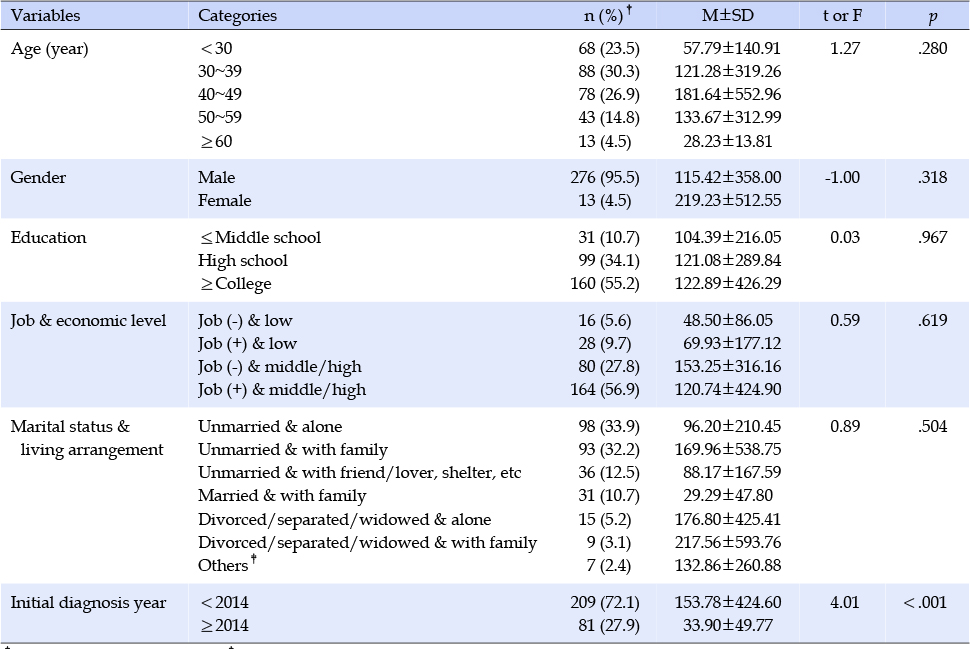References
1. Deeks SG, Lewin SR, Havlir DV. The end of AIDS: HIV infection as a chronic disease. Lancet 2013;382(9903):1525–1533.
10.1016/S0140-6736(13)61809-7.
4. Grinsztejn B, Hosseinipour MC, Ribaudo HJ, Swindells S, Eron J, Chen YQ, et al. Effects of early versus delayed initiation of antiretroviral treatment on clinical outcomes of HIV-1 infection: Results from the phase 3 HPTN 052 randomised controlled trial. Lancet Infect Dis 2014;14(4):281–290.
10.1016/S1473-3099(13)70692-3.
5. Cohen MS, Chen YQ, McCauley M, Gamble T, Hosseinipour MC, Kumarasamy N, et al. Prevention of HIV-1 infection with early antiretroviral therapy. N Engl J Med 2011;365(6):493–505.
10.1056/NEJMoa1105243.
6. Insight Start Study Group. Initiation of antiretroviral therapy in early asymptomatic HIV infection. N Engl J Med 2015;2015(373):795–807.
10.1056/NEJMoa1506816.
8. The Korean Society for AIDS. The 2013 clinical guidelines for the diagnosis and treatment of HIV/AIDS in HIV-infected Koreans. Infect Chemother 2013;45(4):455–461.
10.3947/ic.2013.45.4.455.
9. Liu Y, Ruan Y, Vermund SH, Osborn CY, Wu P, Jia Y, et al. Predictors of antiretroviral therapy initiation: A cross-sectional study among Chinese HIV-infected men who have sex with men. BMC Infect Dis 2015;15(1):570. 10.1186/s12879-015-1309-x.
10. Palmer AK, Cescon A, Chan K, Cooper C, Raboud JM, Miller CL, et al. Factors associated with late initiation of highly active antiretroviral therapy among young HIV-positive men and women aged 18 to 29 years in Canada. J Int Assoc Provid AIDS Care 2014;13(1):56–62.
10.1177/2325957413510606.
11. Hsu LC, Truong HHM, Vittinghoff E, Zhi Q, Scheer S, Schwarcz S. Trends in early initiation of antiretroviral therapy and characteristics of persons with HIV initiating therapy in San Francisco, 2007-2011. J Infect Dis 2013;209(9):1310–1314.
10.1093/infdis/jit599.
12. Alvarez-Uria G. Factors associated with delayed entry into HIV medical care after HIV diagnosis in a resource-limited setting: data from a cohort study in India. PeerJ 2013;1:e90. 10.7717/peerj.90.
13. Plitt SS, Mihalicz D, Singh AE, Jayaraman G, Houston S, Lee BE. Time to testing and accessing care among a population of newly diagnosed patients with HIV with a high proportion of Canadian Aboriginals, 1998-2003. AIDS Patient Care STDS 2009;23(2):93–99.
10.1089/apc.2007.0238.
14. Newman CE, Bonar M, Greville HS, Thompson SC, Bessarab D, Kippax SC. Barriers and incentives to HIV treatment uptake among Aboriginal people in Western Australia. AIDS 2007;21:S13–S17.
10.1097/01.aids.0000255080.46976.18.
15. Begley K, McLaws ML, Ross MW, Gold J. Cognitive and behavioural correlates of non-adherence to HIV anti-retroviral therapy: Theoretical and practical insight for clinical psychology and health psychology. Clin Psychol (Aust Psychol Soc) 2008;12(1):9–17.
10.1080/09540121.2015.1114992.
16. Park Y, Seo MJ, Kim S, Park S. Experience of treatment adherence in Korean patients with HIV. J Korean Acad Nurs 2014;44(4):407–417.
10.4040/jkan.2014.44.4.407.
17. Park YM, Shin G, Kim J. Factors influencing health-promoting behaviors in people living with HIV. Korean J Adult Nurs 2014;26(2):234–243.
10.7475/kjan.2014.26.2.234.
18. Coxe S, West SG, Aiken LS. The analysis of count data: a gentle introduction to Poisson regression and its alternatives. J Pers Assess 2009;91(2):121–136.
10.1080/00223890802634175.
19. Alvarez-Uria G, Pakam R, Midde M, Naik PK. Predictors of delayed antiretroviral therapy initiation, mortality, and loss to followup in HIV infected patients eligible for HIV treatment: Data from an HIV cohort study in India. Biomed Res Int 2013;2013:849042. 10.1155/2013/849042.
20. Cescon A, Patterson S, Davey C, Ding E, Raboud JM, Chan K, et al. Late initiation of combination antiretroviral therapy in Canada: A call for a national public health strategy to improve engagement in HIV care. J Int AIDS Soc 2015;18(1):20024. 10.7448/IAS.18.1.20024.
21. Kohli R, Klein RS, Schoenbaum EE, Anastos K, Minkoff H, Sacks HS. Aging and HIV infection. J Urban Health 2006;83(1):31–42.
10.1007/s11524-005-9005-6.
22. Illa L, Echenique M, Jean GS, Bustamante-Avellaneda V, Metsch L, Mendez-Mulet L, et al. Project ROADMAP: Reeducating Older Adults in Maintaining AIDS Prevention: A secondary intervention for older HIV-positive adults. AIDS Educ Prev 2010;22(2):138–147.
10.1521/aeap.2010.22.2.138.
23. Messer LC, Quinlivan EB, Parnell H, Roytburd K, Adimora AA, Bowditch N, et al. Barriers and facilitators to testing, treatment entry, and engagement in care by HIV-positive women of color. AIDS Patient Care STDS 2013;27(7):398–407.
10.1089/apc.2012.0435.
24. Logie CH, James L, Tharao W, Loutfy MR. HIV, gender, race, sexual orientation, and sex work: A qualitative study of intersectional stigma experienced by HIV-positive women in Ontario, Canada. PLoS Med 2011;8(11):e1001124. 10.1371/journal.pmed.1001124.
25. Alfonso V, Bermbach N, Geller J, Montaner JS. Individual variability in barriers affecting people's decision to take HAART: A qualitative study identifying barriers to being on HAART. AIDS Patient Care STDS 2006;20(12):848–857.
10.1089/apc.2006.20.848.
26. Seo MH, Jeong SH. Life experiences of uninfected women living with HIV-infected husbands: A phenomenological study. J Korean Acad Nurs 2017;47(6):781–793.
10.4040/jkan.2017.47.6.781.
27. Nakimuli-Mpungu E, Wamala K, Okello J, Alderman S, Odokonyero R, Mojtabai R, et al. Group support psychotherapy for depression treatment in people with HIV/AIDS in northern Uganda: A single-centre randomised controlled trial. Lancet HIV 2015;2(5):e190–e199.
10.1016/S2352-3018(15)00041-7.
28. Fox MP, Mazimba A, Seidenberg P, Crooks D, Sikateyo B, Rosen S. Barriers to initiation of antiretroviral treatment in rural and urban areas of Zambia: A cross-sectional study of cost, stigma, and perceptions about ART. J Int AIDS Soc 2010;13(1):8. 10.1186/1758-2652-13-8.
29. Posse M, Baltussen R. Barriers to access to antiretroviral treatment in Mozambique, as perceived by patients and health workers in urban and rural settings. AIDS Patient Care STDS 2009;23(10):867–875.
10.1089/apc.2009.0050.



